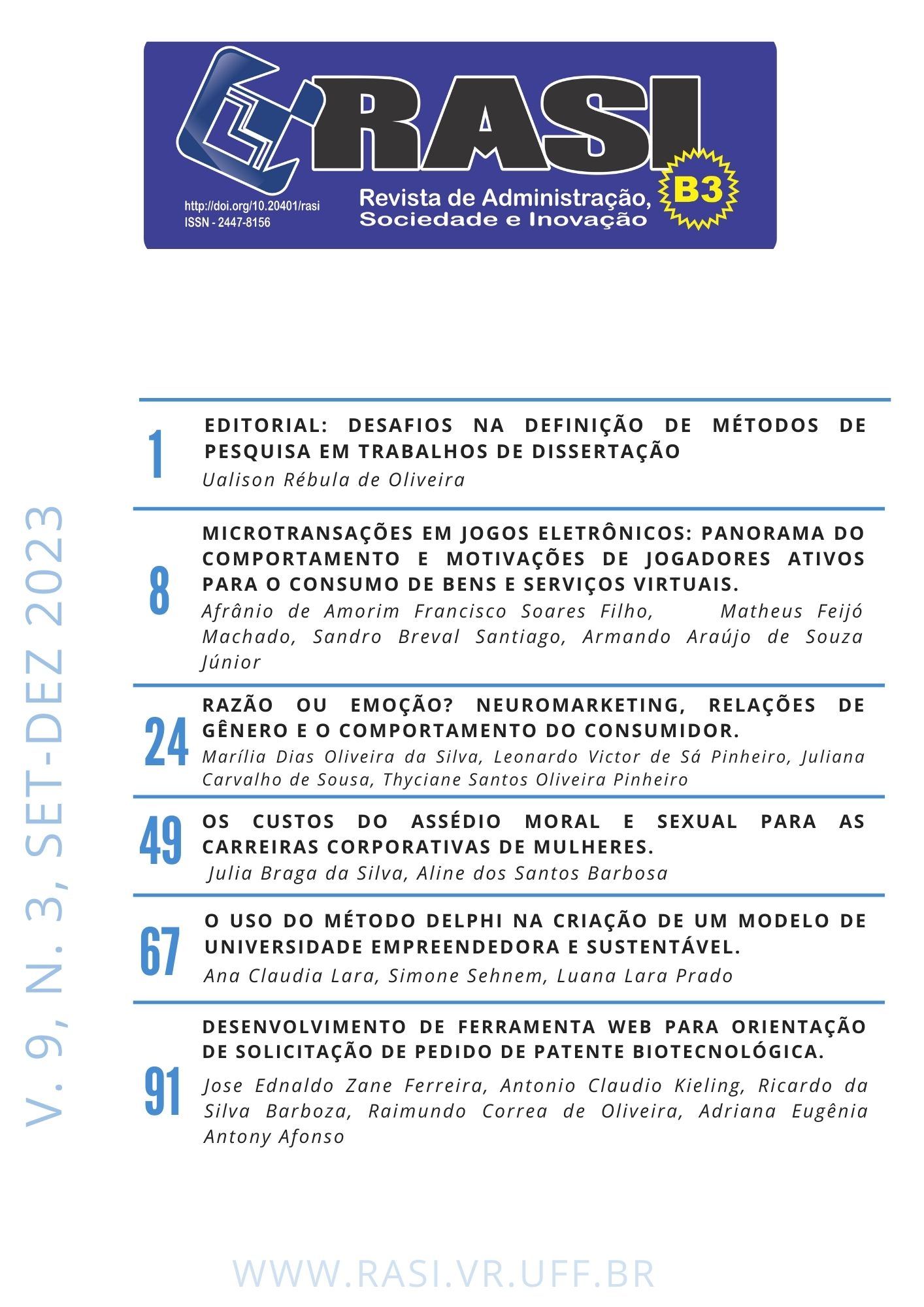Microtransactions in electronic games
overview of the active player’s behaviors and motivations to consume virtual goods and services
DOI:
https://doi.org/10.20401/rasi.9.3.724Keywords:
marketing em jogos online, marketing digital, comportamento de consumo, microtransações, jogos eletrônicos;Abstract
The success of “freemium” monetization models has made microtransactions one of the most profitable consumer niches in the video game industry. With more than 2.5 billion gamers, this market attracts notable academic interest, as well as stimulates the creativity and daring of manufacturers interested in understanding the profiles and increasing the interest of users for items or services sold in the game. The purpose of this work was to identify, together with active users of electronic games, profiles, preferences, interests and motivations to buy items or services in the game, through microtransactions. The study was quantitative and descriptive, data were collected empirically using an online survey on the Google docs platform and the questionnaire built, adapting scales found in the literature. Treatment and analysis using descriptive, uni and multivariate statistics and the significance of the scales tested by Fisher's chi-square, relevance from 95%. Among the main results, we highlight the behavior of three groups, casuals, neutrals and whales, identified by combinations and intensities between purchased items, occasions and motivations. For part of the sample, Covid-19 pandemic intensified game’s consumption. Skins, expansions and virtual currencies are the most purchased. Promotions, reward passes and special events are the ones that most attract buyers looking for value for money or extra content. Purchases to expedite content unlocking or without knowing the rewards are unattractive. Also, they are less likely to spend for status or influence from others. They don’t admit investing to reach the best players, however, value staying among them.
Downloads
References
Amélio, C, O. (2018). A indústria e o mercado de jogos digitais no Brasil. XVII SBGames. Foz do Iguaçu, Brasil. Disponível em: https://www.sbgames.org/sbgames2018/files/papers/IndustriaFull/188510.pdf . 1497, 1505- 1506.
Andrade, D, R. (2019). O Impacto das microtransações num mundo digital. Tese (Mestrado em Gestão e Estratégia Industrial) – Lisbon School of Economics & Management – Universidade de Lisboa, Lisboa, 12-14.
Artz, B., & Kitcheos, A. (2016). Microtransactions: A Study of Consumer Behavior and Virtual Goods/ Services Among Students at Linkoping. Bachelor Thesis (Business Administration) – Linkoping University, Sweden, 11-18.
Ayrosa, E, A, T., & Cerchiaro, I, B. (2014). Pesquisa Quantitativa e Qualitativa em Marketing: Compreendendo Diferenças, Produzindo Confluências. Revista ADM. MADE, 18(3).
Curcelli, M, C, P. (2018). Loot boxes e o mercado de consumo no Brasil. Trabalho de Conclusão d Curso (Bacharelado em Direito) – Universidade Presbiteriana Mackenzie, 43-45.
Dmitriev, P. (2019). The Growth of Gamers in Emerging Markets. MIRAE ASSET Global Investments, 1-3. Disponível em: https://am.miraeasset.com.br/wp-content/uploads/sites/154/2020/05/The_Growth_of_Gamers_in_Emerging_Markets.pdf. Acesso em 22/06/2021.
Esposito, N. (2005). A short and Simple Definition of What a Videogames Is. DIGRA `05 – 2005 DiGRA International Conference: Changing Views: Worlds in Play: 1-3. Vancouver, British Columbia, Canada. Disponível em: http://www.digra.org/digital-library/publications/a-short-and-simple-definition-of-what-a-videogame-is/.
Fang, J. (2019). In-Game Currency Design and Consumer Spending Behavior. Senior Thesis – Michigan Ross Senior Thesis Seminar – University of Michigan, Michigan, 6-8.
Fernandez, L., Williams, A, J., & Kuss, D, J. (2019). Measuring Female Gaming: Gamer Profile, Predictors, Prevalence, and Characteristics from Psychological and Gender Perspectives. Frontiers in Psychology, 10(1).
Gil, A, C. (2002). Como elaborar projetos de pesquisa. Ed. Atlas, 4° Edição: São Paulo, 42 – 43.
Hair, J. F., Black, W. C., Babin, B. J., Anderson, R. E., & Tatham, R. L. (2009). Análise multivariada de dados. Bookman editora.
Iqbal, M. (2021). App Revenue Data - Business of Apps. 2021. Disponível em: https://www.businessofapps.com/data/app-revenues/.
Kattilakoski, J. (2019). The Growth of Video Game Industry: Current Status and Future Prospects. Thesis (Bachelor of Business Administration) – Metropolia University of Applied Sciences, 6-11.
Kinchescki, G, F; Alves, R. e Fernandes, T, R, T. (2015). Tipos de metodologias adotadas nas dissertações do programa de pós-graduação em administração universitária da Universidade Federal de Santa Catarina, no período de 2012 a 2014. XV Colóquio Internacional de Gestão Universitária – CIGU, Mar del Plata/Argentina, 4-5.
King, D, L., Delfabbro, P. H., Gainsbury, S. M., Dreier, M., Greer, N., & Billieux, J. (2019). Unfair play? Video games as exploitative monetized services: An examination of game patents from a consumer protection perspective. Computers in Human Behavior, 101, 131-133.
Lima, W, S, B. (2018). Videogame não é bobagem: Construindo infográficos sobre consumo e mercado. Trabalho de Conclusão de Curso (Bacharelado em Comunicação Social – Publicidade e Propaganda) – Centro de Ciências Sociais e Humanas – Universidade Federal de Santa Maria, 16-20.
Malhotra, N. K. (2019). Pesquisa de Marketing-: uma orientação aplicada. 7ª ed., Bookman Editora.
Martins, C, G. e Ferreira, M, L, R. (2011). O survey como tipo de pesquisa aplicado na descrição do conhecimento do processo de gerenciamento de riscos em projetos no segmento da construção. VII Congresso Nacional de Excelência em Gestão. Rio de Janeiro – Brasil, 2-4.
Nielsen, R. K. L., & Grabarczyk, P. (2019). Are Loot Boxes Gambling? Transaction of the Digital Games Research Association, 4(3), 173-174. Acesso em: 24/06/21.
Pashkov, S. (2021). Video Game Industry Market Analysis: Approaches that resulted in industry success and high demand. Unit International Business Administration, 14-15.
Petrovskaya, E., & Zendle, D. (2020). The Battle Pass: a Mixed-Methods Investigation into a Growing Type of Video Game Monetisation. Disponível em: https://doi.org/10.31219/osf.io/vnmeq .
Reza, A., Nedd, A., Chu, S., Castillo, A., Khan, Z., & Gardner, D. (2020). I like the Way the Skin Looks: Player Perspectives on Aesthetic Appeal and Self-Representation with Video Game “Skins ”. IDEALS – Illinois Digital Environment for Access to Learning and Scholarship, 2, 5-6. Disponível em: https://www.ideals.illinois.edu/handle/2142/106593 . Acesso em 03/10/21.
Riot Games. (2020). Métodos de pagamento. Disponível em: https://www.leagueoflegends.com/pt-br/news/riot-games/metodos-de-pagamento/ .
Rodrigues, D, F. (2021). Consumo impulsivo e jovens consumidores: compras via aparelhos celulares. Tese (Mestrado em Administração) – Universidade Federal da Paraíba, 53(75/78).
Rosa, E. C. (2015). O conhecimento científico da metodologia: Com o olhar para o método hipotético dedutivo como ferramenta de pesquisa. Revista Iniciação & Formação Docente Dossiê do X Seminário de Leitura e Produção no Ensino Superior, 2(2), 6-7.
Rosado, D, G. (2020). Fatores que influenciam a decisão de compra do consumidor de jogos eletrônicos. Trabalho de Conclusão de Curso (Bacharelado em Administração) – Universidade Federal do Rio Grande do Norte, 33-36.
Serafim, M. C., Gonçalves, G. F., Souza, D. E. S., & Santos, Ítalo A. T. (2022). Principais fatores que influenciam a intenção de compra de bens virtuais em jogos gratuitos. Future Studies Research Journal: Trends and Strategies, 14(1), e0582. https://doi.org/10.24023/FutureJournal/2175-5825/2022.v14i1.582
Shaw, S., Quattry, S., Whitt, J., & Chirino, J. (2020). The Global Gaming Industry Takes Center Stage. Morgan Stanley Investment Management – Global Emerging Markets Team, 1-4. Disponível em: https://www.morganstanley.com/im/publication/insights/articles/article_globalgamingindustrytakescentrestage_us.pdf . Acesso em 22/06/2021.
Sweeny, D, J., Williams, T, A., & Anderson, D. R. (2014). Estatística aplicada à administração e economia. Cengage Learning, 6° Edição, 35-36,.
Takahara, V, M. (2020). Microtransações em jogos eletrônicos: Um estudo sobre percepção dos usuários sobre os itens funcionais e ornamentais. Tese (Mestrado em Economia) – FGV-SP, 15-16.
Wardle, H. (2019). The Same or Different? Convergence of Skin Gambling and Other Gambling Among Children. Journal of Gambling Studies, 35(4), 1110-1111.
Wardle, H., & Zendle, D. (2020). Loot Boxes, Gambling, and Problem Gambling Among Young People: Results from a Cross-Sectional Online Survey Cyberpsychology, Behavior and Social Networking, 24(4).
Zendle, D e Cairns, P. (2018). Video game loot boxes are linked to problem gambling: Results of a large-scale. PLoS ONE, 13(11), 6-8.
Zendle, D. (2020). Beyond loot boxes: a variety of gambling-like practices in video games are linked to both problem gambling and disordered gaming. Peer Journal, 4.
Zendle, D., Meyer, R., & Over, H. (2019). Adolescents and loot boxes: links with problem gambling and motivations for purchase. Royal Society Open Science, 6, 1-5.
Zendle, D., Meyer, R., & Ballou, N. (2020). The changing face of desktop video game monetization: An exploration of exposure to loot boxes, pay to win, and cosmetic microtransactions in the most played Steam games of 2010-2019. PLos ONE, 15(5), 1-6.
Zhirkova, K e Saric, N. (2020). Cushioning the Pain of Playing through Microtransactions in Online Gaming. Thesis (Master of Science) – BI Norwegian Business School, 27.
Downloads
Published
Issue
Section
License
Copyright (c) 2023 Review of Administration, Society and Innovation

This work is licensed under a Creative Commons Attribution 4.0 International License.
RASI, in accordance with Law No. 9,610 of February 19, 1998, which amends, updates and consolidates Brazilian copyright law and makes other provisions, adopts the following conditions of the Copyright Assignment:
1. RASI maintains, with the transfer of copyrights, the possession of rights over the content published;
2. The author retains his moral rights of the content, including the right to be identified as the author whenever the content is published;
3. Despite the attribution of copyright, the author retains the right to reuse the material in future collections of his own work without encumbrance. The acknowledgments of the previous publication in the RASI are the only requirements in such cases;
4. The author may make photocopies of the content, or distribute it by electronic mail or fax, provided that they are intended for their own classes and for the purpose of meeting research objectives, provided that: (a) such copies are not resold and (b) reference to the original source of the publication and the name of the RASI are clearly indicated on all copies made of the document.











